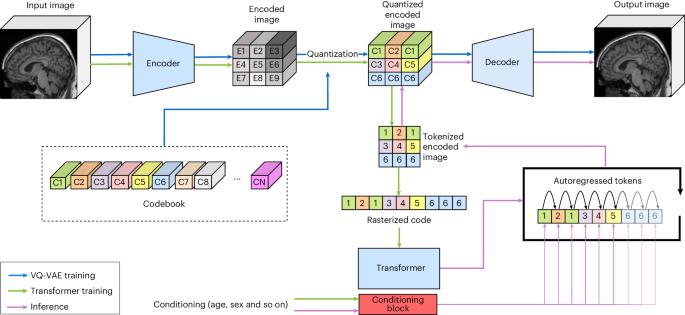Realistic morphology-preserving generative modelling of the brain
IF 18.8
1区 计算机科学
Q1 COMPUTER SCIENCE, ARTIFICIAL INTELLIGENCE
引用次数: 0
Abstract
Medical imaging research is often limited by data scarcity and availability. Governance, privacy concerns and the cost of acquisition all restrict access to medical imaging data, which, compounded by the data-hungry nature of deep learning algorithms, limits progress in the field of healthcare AI. Generative models have recently been used to synthesize photorealistic natural images, presenting a potential solution to the data scarcity problem. But are current generative models synthesizing morphologically correct samples? In this work we present a three-dimensional generative model of the human brain that is trained at the necessary scale to generate diverse, realistic-looking, high-resolution and morphologically preserving samples and conditioned on patient characteristics (for example, age and pathology). We show that the synthetic samples generated by the model preserve biological and disease phenotypes and are realistic enough to permit use downstream in well-established image analysis tools. While the proposed model has broad future applicability, such as anomaly detection and learning under limited data, its generative capabilities can be used to directly mitigate data scarcity, limited data availability and algorithmic fairness. Medical imaging research is limited by data availability. To address this challenge, Tudosiu and colleagues develop a 3D generative model of the human brain that can generate high-resolution morphologically correct brains conditioned on patient characteristics.


逼真的大脑形态保存生成模型
医学影像研究往往受限于数据的稀缺性和可用性。管理、隐私问题和获取成本都限制了医学影像数据的获取,再加上深度学习算法对数据的渴求,限制了医疗人工智能领域的进展。最近,生成模型被用于合成逼真的自然图像,为数据稀缺问题提供了潜在的解决方案。但目前的生成模型是否能合成形态正确的样本呢?在这项工作中,我们提出了一个人脑三维生成模型,该模型经过必要的训练,可生成多样化、逼真、高分辨率和形态保持良好的样本,并以患者特征(如年龄和病理)为条件。我们的研究表明,该模型生成的合成样本保留了生物和疾病表型,而且足够逼真,可用于成熟的图像分析工具的下游。所提出的模型在未来具有广泛的适用性,如异常检测和有限数据下的学习,其生成能力可用于直接缓解数据稀缺、有限数据可用性和算法公平性等问题。
本文章由计算机程序翻译,如有差异,请以英文原文为准。
求助全文
约1分钟内获得全文
求助全文
来源期刊

Nature Machine Intelligence
Multiple-
CiteScore
36.90
自引率
2.10%
发文量
127
期刊介绍:
Nature Machine Intelligence is a distinguished publication that presents original research and reviews on various topics in machine learning, robotics, and AI. Our focus extends beyond these fields, exploring their profound impact on other scientific disciplines, as well as societal and industrial aspects. We recognize limitless possibilities wherein machine intelligence can augment human capabilities and knowledge in domains like scientific exploration, healthcare, medical diagnostics, and the creation of safe and sustainable cities, transportation, and agriculture. Simultaneously, we acknowledge the emergence of ethical, social, and legal concerns due to the rapid pace of advancements.
To foster interdisciplinary discussions on these far-reaching implications, Nature Machine Intelligence serves as a platform for dialogue facilitated through Comments, News Features, News & Views articles, and Correspondence. Our goal is to encourage a comprehensive examination of these subjects.
Similar to all Nature-branded journals, Nature Machine Intelligence operates under the guidance of a team of skilled editors. We adhere to a fair and rigorous peer-review process, ensuring high standards of copy-editing and production, swift publication, and editorial independence.
 求助内容:
求助内容: 应助结果提醒方式:
应助结果提醒方式:


